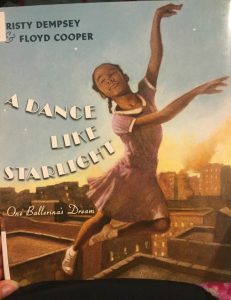Author(s): Kristy Dempsey
Illustrator/Photographer: Floyd Cooper
Publisher and Year: Philomel Books in 2014
Number of Pages: 28
Genre: Historical Fiction
Analysis:
This story is set in New York in the 1950s, and is about a little African American girl who goes with her mother to work, which is at a ballet school, and she falls in love with ballet. The story continues with the young girl always wishing and dreaming of becoming a prima ballerina, and one day the Ballet Master sees her dancing backstage and allows her to join ballet lessons at the school. At the end of the story, the little girl’s mother takes her to see Janet Collins perform at the Metropolitan Opera House, as she debuts as the first African American prima ballerina, and the little girl then realizes that she can do anything she sets her mind to.
The illustrations in this book are large and drawn with detail. All the images have a pinkish-brown color scheme, which I believe adds warmth to the images and makes the reader feel comfortable with the main character. The illustrations are also unframed and take up the whole page, which helps the reader to feel as though they are also experiencing everything with the characters. Also, the way the text is placed on each page almost resembles movement and dancing, which can be related to the little girl’s never ending dream of becoming a dancer and how she is always moving towards her end goal.
When first reading through this story I thought it was a great story about a little girl who never gives up on her dreams of dancing, but after reading through the story again, and reading the author’s note, I realized that there was a deeper message within this story. The author was inspired to write this story based on the true event of Janet Collins becoming the first prima ballerina to be hired from the Metropolitan Opera, and the story briefly touches on segregation within the U.S. pre-Civil Rights Movement. I believe that this story could be used as a window for children to learn about segregation and how everyone was not allowed the same opportunities. However, this story does not explicitly state anything about segregation or the Civil Rights Movement, and the young girl is portrayed in a way that is very happy, which does not send the reader the correct message about the hardships that many African Americans may have faced during the 1950s. I also think this book can be used as a mirror for African American children who may feel like they have struggled with having the same opportunities as white children, and also for children who are living with a single parent who has to work a lot in order to provide support for their family. This book could also be used as a door to teach children to never give up on their dreams. Overall, I believe this story does a great job of encouraging children to follow their dreams, but I am not sure that this book accurately represents the way many African Americans felt during segregation.


